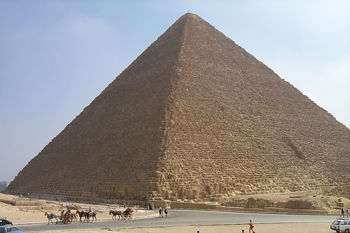Ancient Egypt

The Great Pyramid of Giza is the most striking monument left by the people of Ancient Egypt.
- See also: History of Egypt
Egypt has been inhabited for the past ten thousand years, from prehistoric Egypt, and its ancient culture was one of the most important in antiquity, producing monuments like the Sphinx and pyramids. It was first united around 3200 BCE, by the Wild Bull Lord, Menes. The civilization created lasted for the next 3,000 years until 332 BCE, when it was conquered by Alexander the Great. This era produced many magnificent temples and monuments, and of course the pyramids.
Early Dynastic Period (c.3,100 BCE - 2,686 BCE)
By about 3,100 BCE, Egypt's early civilization had formed around one ruler. At this time, Hor-Aha, first king of Egypt, came to power, after the land was unified by his predecessor, Narmer. He and the next seven monarchs made up Egypt's first dynasty: Djer, Djet, Merneith, Den, Anedjib, Semerkhet and Qa'a.[1] Narmer, however, is sometimes identified as the first true king, and there may have been other monarchs at this time whose names have been lost.
Old Kingdom
First Intermediate Period
Middle Kingdom
The middle kingdom lasted from about 2050 B.C. to about 1670 B.C. . In the middle kingdom, the Egyptians enjoyed a golden age of prosperity and achievement.During the middle kingdom Egypt attacked new lands including Nubia and what is now Syria.
Second Intermediate Period
New Kingdom
During the new kingdom Ancient Egypt reached the height of its power, becoming the richest and most powerful in its history
Third Intermediate Period
Late Period (664 BCE - 332 BCE
Conquest of Alexander the Great
Alexander the Great and his armies arrived at Egypt in the autumn of 332 BCE. Initially the Persian governor (satrap) tried to resist him, but he soon surrendered, thus ending the second period of Persian domination over the country. Egyptian sources describe Persian rule as oppressive, so Alexander was seen more as a liberator than a conqueror.
Alexander travelled to the Oasis of Siwa in the Libyan Desert, famous for its oracle of the god Amun. The oracle is said to have declared him son of the god and therefore King of Egypt. In Memphis, he was crowned Pharaoh according to the Egyptian ceremony. He adopted as his throne name Mery-amun-Setepenre, which meant 'Beloved of Amun, Chosen by Re'. Rumours that Alexander was the fruit of an affair between Olympias and Nectanebo II, Egypt’s last native pharaoh, further helped to secure his status as new ruler of Egypt.
In the western region of the Nile Delta, at the site of a small Egyptian settlement called Raqote (or Rakhotis), he founded a new city, Alexandria. Although Alexander would establish new cities during his expedition (over 70, according to sources), Alexandria became the most important, an economic and cultural center of the Mediterranean world during the Ptolemaic and Roman periods. Alexander left Egypt in the spring of 331 BCE, leaving the administration of the country in the hands of Kleomenes of Naukratis and Ptolemy, one of his generals.
Footnotes
- ↑ BBC News: 'New timeline for origin of ancient Egypt'.